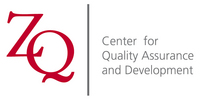Tools for evaluating the quality of courses from the students' point of view are in continuous development. Here, the quality of courses is regarded as a four-dimensional construct. Based on Parsons, the university is understood as a functionally differentiated social system. Its key functions can be described in terms of a four-cell schema (AGIL schema). In the Mainz model, however, Parsons' structural-functional theory is linked up with the differentiation of three dimensions of quality according to Donabedian (1980), i.e. the quality of structures, processes, and results. Added to this is a fourth level of quality, i.e. that of goals and values. These four dimensions of quality can be applied to the university system and underlie the evaluations done by the JGU Center for Quality Assurance and Development. They are also applied within the context of quality evaluation of courses. Thus, the following key questions can be formulated for each dimension:
Quality of goals:
- What is the objective of the course?
- What knowledge and skills should be imparted by the course?
Quality of structures:
- What resources – both in terms of staff and material resources – bodies of knowledge are provided by the university?
- What resources (prior knowledge, time, interest, motivation) do the students bring to the table?
Quality of processes:
- How good are the processes of coordination, communication, interaction, and cooperation within the course?
Quality of results:
- What results are achieved in the course in terms of knowledge transfer, education, training and research?
Based on these key questions, various features of a course could be matched to the dimensions in question (see diagram). Each of these features can be captured by one or more questions in the questionnaire, although not all of the features listed here can be evaluated by the students and thus cannot be included in the questionnaire.
